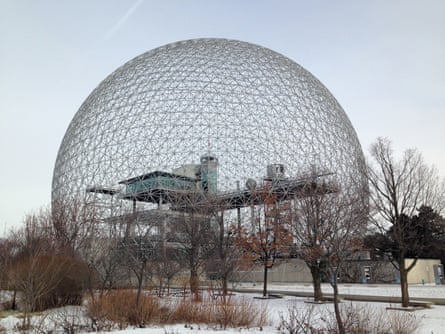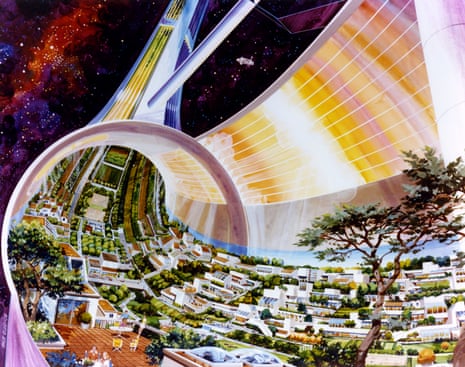During the anxious early 1970s, when the west was spooked by the oil crisis and economic stagnation, by the first widespread fears for the environment and predictions of global overpopulation, a giddy alternative to it all began to seize the imaginations of some Americans: space colonies. “Large cylinders, potentially over a kilometre long,” Douglas Murphy writes in Last Futures, “would spin at a constant rate to recreate the effects of gravity … [and] would be partially glazed to allow for sunlight … while large shades and baffles would protect the inhabitants from glare and cosmic rays … with water features, trees, animals and people all sheltered within this artificial environment, and outside the blank vacuum of space”.
For several years the space colony craze spread, from the most speculative edges of academia to the more intellectually active parts of the counterculture, to the American government itself. Murphy records that Gerard O’Neill, a Princeton University particle physicist and space colony advocate, “gave evidence to the US Senate on the prospect … and Nasa began to publicise the idea”. It was not until the late 70s that funding cuts ended this official interest, and condemned the artists’ impressions of space colonies produced by Nasa to be remembered, if at all, as science fiction kitsch.
Murphy reprints one of the illustrations, an absurdly optimistic panorama of terraced gardens and villas inside a gigantic, floating tube, like an orbiting chunk of California. But the purpose of his book is not easy mockery or unthinking nostalgia – still the simplistic responses of most authors to the surge of utopianism that swept through architecture and city planning in America and other rich countries during the 60s and 70s. Instead, Murphy aims to look anew at the towers and domes and ziggurats that were built, or just sketched, in these ambitious years: at what was achieved, what went wrong, and whether there are any worthwhile structures or ideas left for our own anxious era.
He starts a little predictably, with the futuristic pavilions that were erected at international expositions in the 60s, which were then highly competitive, cold war gatherings of rival national aesthetics and visions of progress, usually involving a lot of glass. Murphy writes with infectious fervour about innovators such as Buckminster Fuller, the American pioneer of quick, cheap, bubble architecture, “who wore glasses so thick his eyes seemed as big as dinner plates”. But charismatic inventors and colourful world fairs are over-familiar cultural history topics.
The book becomes more compelling when it starts to explore the social and political implications of the minimal, yet capacious, buildings that Fuller and others were designing. Because they were modular in construction, barely decorated and light in all senses – little more than shells – they could easily be extended or their internal layouts changed. They were “suited to conditions of rapid social and technological change”. The 60s and 70s were exactly such a period, with consumerism, individualism and political radicalism all on the rise. The new architecture, in theory, could house whatever its users wished: a leisure centre, a shopping centre, a commune. Murphy provides a vivid succession of examples, from Drop City, an anarchist encampment built out of thrown-together domes in rural Colorado, to Summerland on the Isle of Man, a giant plastic and steel pleasure complex incorporating everything from swimming to slot machines to fake log cabins.
Contrary to the usual complaint about postwar architecture, that it treated “ordinary human beings [as] material to be moulded in the service of a grand vision”, as Murphy puts it, this book bravely argues that in some visionary, now-neglected, buildings the relationship between people and architecture was the other way round. Socially conscious architects, working in crowded places from Montreal to the London borough of Camden, wanted to make life more free as well as more equal – the great, forgotten goal of more thoughtful members of the postwar western left. In mass housing, Murphy shows, one apparent solution was the ziggurat: arranging flats in pyramids or irregular stacks, rather than uniform towerblocks, so that every dwelling had its own particular identity and private garden.
He visits one famous and still functional example, the halls of residence at the University of East Anglia, sloping structures sitting unexpectedly in parkland like a row of vast landed spacecraft, which were designed in the 60s by Denys Lasdun, one of many adventurous British architects in the book. Murphy finds the experience both thrilling and saddening: “The visitor is immersed in a world that now seems long gone … a bucolic late 1960s world of concrete and trees, of a future faced expectantly.”

Not many ziggurats were built, in Britain or anywhere else. They were too expensive compared with tower blocks, the reader assumes, but Murphy doesn’t say. Instead, he describes the fall of idealistic architecture from the 70s onwards in other ways. Sometimes, the buildings simply weren’t constructed or maintained well enough. On a summer evening in 1973, after two years of successful business, entertaining thousands of visitors at a time, the Summerland leisure centre caught fire. Started by a cigarette, the blaze spread up a wall that had been built of partly flammable coated steel instead of concrete to save money, moved quickly through the open-plan interior, and melted the innovative plastic panels in the roof, which dripped on to those trying to flee. Fifty people died, many because fire doors had been locked to stop visitors getting in without paying. But it was widely believed that the architecture alone was to blame.
The brief vogue for such huge experimental buildings, or “megastructures” as they were known by their designers and denouncers, was also undermined by conservation campaigns against the sweeping redevelopment of places such as Lower Manhattan and Covent Garden – although Murphy perceptively points out that rising rents and gentrification have now erased most of the traditional urban life defended by those campaigns anyway. More provocatively still, he argues that, since the 60s, architecture itself, as a source of epic spectacle, has gradually been made obsolete by technology: first by television and video, then by the infinite vistas of the internet. Some of those who crusaded for space colonies, in many ways the culmination and last gasp of the megastructure movement, turned to creating online spaces when their physical project failed.
Murphy regrets this dwindling interest in revolutionising the built environment: the social and environmental problems that his favourite architects tried to solve have hardly gone away. Yet some of his later chapters, too, drift away from architecture and into potted summaries and discussions of postwar thinkers such as Stewart Brand and Herbert Marcuse, who did much to shape the era’s alternately doomy and excitable attitudes to progress, but whose connection to architecture is not always made clear. In these sections Murphy’s writing, usually sharp and concentrated, becomes slightly starchy and academic. “Germinal”, meaning the early stages of something, is a good word to use in a book about hopes and innovations, but perhaps not quite so often.

Meanwhile, there is tantalisingly little actual description of the architecture of communes and the other structures erected by the 60s and 70s counterculture, the DIY counterpart to the period’s bold new campuses and housing estates. After Drop City was abandoned in the 70s, we learn, it became “an odd, scrappy ruin still visited by dropouts long afterwards”. It would have been fascinating to have Murphy’s analysis of all the photos of the commune buildings in their heyday that are available online; even better had he poked around the site for remnants.
During the 80s, most of the utopian architectural schemes of the previous two decades were so quickly forgotten or derided – “Nothing dates faster than people’s fantasies about the future,” sneered the art critic Robert Hughes in 1980 – that it was almost as if they had never existed. Murphy tells the story of this counter-revolution pithily and well. This is not a long book, but it is really about much more than buildings; it is a fresh and haunting way of explaining what happened to the radical 60s and 70s as a whole, in Murphy’s view quite possibly the last chance the west had of creating a decent and environmentally sustainable society.
Like all good revisionist history, the book concludes unexpectedly. The flexible, socially responsive sort of building first conceived by progressive postwar architects lives on, he writes, but it has mutated into the supermarket, the open-plan office, the distribution warehouse – not usually spaces of liberation but of control. In Britain and beyond, the 60s and 70s did contain the seeds of a new world, just not quite the one Murphy’s heroes imagined.

Comments (…)
Sign in or create your Guardian account to join the discussion